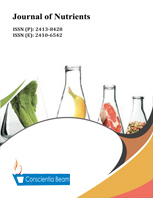Development and Quality Evaluation of Complementary Food Formulated from Sorghum, Soybean and Sesame Flour Blends
DOI:
https://doi.org/10.18488/journal.87.2019.51.1.10Abstract
Complementary foods are foods that are not breast milk or infant formula introduced to an infant to provide nutrients due to inadequacy of breast milk. The quality of Complementary foods prepared from sorghum, soybean and sesame flour blends was determined in this research. The flours were prepared and blended at different ratios; 70:30:0, 70:20:10, 60:30:10, and 50:40:10. The chemical, sensory and physical properties of the individual flours and the most acceptable complementary food were determined. The results show that the complementary food (50% SORF, 40% SOYF AND 10% SESF) contained 24.1% protein while SORF, SOYF and SESF had 7.8%, 48.4% and 15.1% respectively. The complementary food has higher carbohydrate 48.1% than those of the SOYF (19.4%) and SESF (23.3%). However, the SOYF flour had higher carbohydrate (82.2%) than the other flours. The bulk density of the complementary food was 0.72g/cm3 while those of the flours ranged from 0.53 g/cm3 to 0.81g/cm3. All the flours lacked foaming capacity, values ranging from 0.98 to 6.9%. However, the complementary food had higher water absorption capacity and emulsion capacity than the individual flours. The sensory evaluation result showed that the blend containing 50% SORF, 40% SOYF and 10% SESF received higher scores for taste, flavor, texture, colour and overall acceptability than the other flour blends and the commercial weaning food. The result showed that acceptable complementary food with chemical and physical properties similar to commercial weaning food may well be prepared from sorghum, soybean and sesame flour blends.

